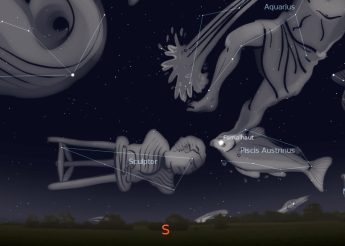This Week’s Sky at a Glance, 2024 Oct. 19 – Oct. 26
This Week’s Sky at a Glance, 2024 Oct. 19 – Oct. 26
The western side of the Square of Pegasus points southward to the solitary bright star Fomalhaut in the mouth of Piscis Austrinus, the Southern Fish. Fomalhaut is the 17th brightest star in our night sky, and astronomers have known it is surrounded by discs of debris for many years. In 2008 an exoplanet was imaged near the inner edge of a disc but more recent images have shown it be the remnants from a collision. The eastern side of Pegasus points down to Diphda, the brightest star in the tail of Cetus the Whale. A circlet of stars well to the east forms the head of the whale.
Between Piscis Austrinus and Cetus is the dim constellation Sculptor, which is a shortened version of its original name, Apparatus Sculptoris (the sculptor’s studio), given by Louis de Lacaille in the 18th century. By 11 pm it is low in the south but it does have a prominent marker. Use binoculars to seek out a long triangle of dim stars stretching eastward from Fomalhaut, but don’t be discouraged if your attempt to locate Sculptor is a bust.
This Week in the Solar System
Saturday’s sunrise is at 7:46 and sunset will occur at 6:31, giving 10 hours, 45 minutes of daylight. Next Saturday the Sun will rise at 7:56 and set at 6:19, giving 10 hours, 23 minutes of daylight.
The Moon is near Jupiter on Monday evening, near Pollux and Mars on Wednesday, and it is at third quarter phase on Thursday. Venus shines brightly low in the southeast in the early evening, setting around 8 pm midweek. Mercury is in the evening sky but it sets too soon after sunset to be seen comfortably. Saturn is at its highest and best for observing in late evening, showing off its rings nearly edge-on. Jupiter will be rising around 9 pm midweek, and on Thursday telescope users might catch its moon Io disappearing into the planet’s shadow at 9:55. Reddish Mars can be seen rising below Gemini around 11:30, making its way toward Cancer over the week.
With the Moon out of the sky in early evening, comet C/2023 A3 Tsuchinshan-ATLAS should remain a beautiful sight in binoculars, approximately a hand-span above Venus and a fist-width to the right this weekend. It will climb up through Ophiuchus over the week. The Orionid meteor shower, caused by remnants of Halley’s comet, peaks on Monday morning. Look for shooting stars emanating from Orion’s upraised club. Tune in to the Sunday Night Astronomy Show at 8 pm on the YouTube channel and Facebook page of Astronomy by the Bay.

